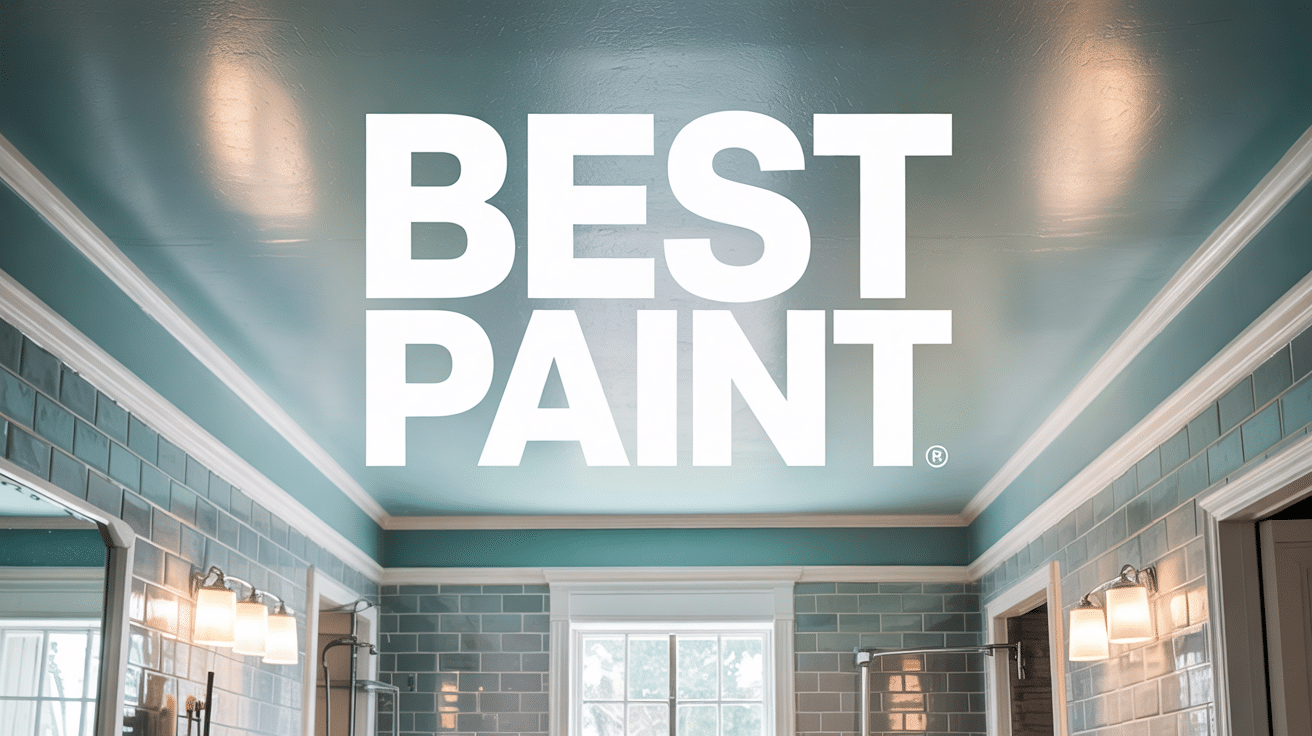Water spots, mold, and flaking paint on your bathroom ceiling? You’re not alone in this common household problem. Many homeowners struggle to find paint that stands up to the wet, humid conditions in bathrooms.
Did you know that using the wrong paint can lead to more repairs within months? The right choice saves both time and money in the long run.
Want a bathroom ceiling that stays clean and fresh for years? The secret lies in selecting a paint made for high-moisture areas. With the correct paint, you can say goodbye to constant touch-ups and hello to a long-lasting finish.
Ready to fix your bathroom ceiling once and for all? Let’s look at the best paint options for your bathroom ceiling and how to pick the perfect one for your needs.
Why Ceiling Paint Matters in Bathrooms
Bathrooms create tough conditions for paint. Unlike other rooms, bathroom ceilings face daily moisture and temperature shifts.
Hot showers send water vapor up to the ceiling where it can stick. This ongoing dampness leads to problems if you use the wrong paint.
- Moisture collects on ceiling surfaces
- Temperature shifts cause paint to expand and contract
- Soap and cleaning products can damage standard paint
Without proper paint, you’ll see water stains, peeling, and bubbling. Worse yet, damp spots can grow mold and mildew quickly.
- Mold may cause health issues
- Mildew creates ugly spots
- Both can spread to other surfaces
The right paint forms a shield against moisture problems. Good bathroom ceiling paint:
- Blocks water damage
- Stops mold and mildew growth
- Keeps its look despite harsh conditions
A well-painted ceiling helps the whole bathroom look clean and fresh, making the space feel larger and brighter for years without touch-ups.
Key Characteristics of Bathroom Ceiling Paint
- Moisture Resistance: Bathroom ceiling paint must create a tight seal against water vapor. This stops moisture from seeping into the ceiling material, which would lead to bubbling, cracking, and damage over time. Look for paints with high moisture ratings made just for wet areas.
- Mildew and Mold Prevention: Quality bathroom paints contain special compounds that block the growth of mold and mildew. These additives work by making the paint surface hostile to spores, giving long-term protection in damp conditions without harmful chemicals.
- Durability: Bathroom ceilings need paint that can handle constant moisture cycles without breaking down. A good paint will maintain its bond with the ceiling through years of humidity shifts, staying put where lesser paints would peel, crack or flake.
- Washability: Bathroom ceilings collect steam, soap residue, and sometimes splashes. The right paint creates a surface you can wipe clean without damaging the finish or color. This makes upkeep simple and extends the time between repaints.
- Stain Resistance: Water stains and marks show clearly on ceilings. Top bathroom paints resist staining and discoloration, keeping the surface looking fresh and clean even after exposure to water and bath products.
Types of Paint Suitable for Bathroom Ceilings
Choose the right finish for your bathroom’s needs and conditions.
1. Flat/Matte Paint
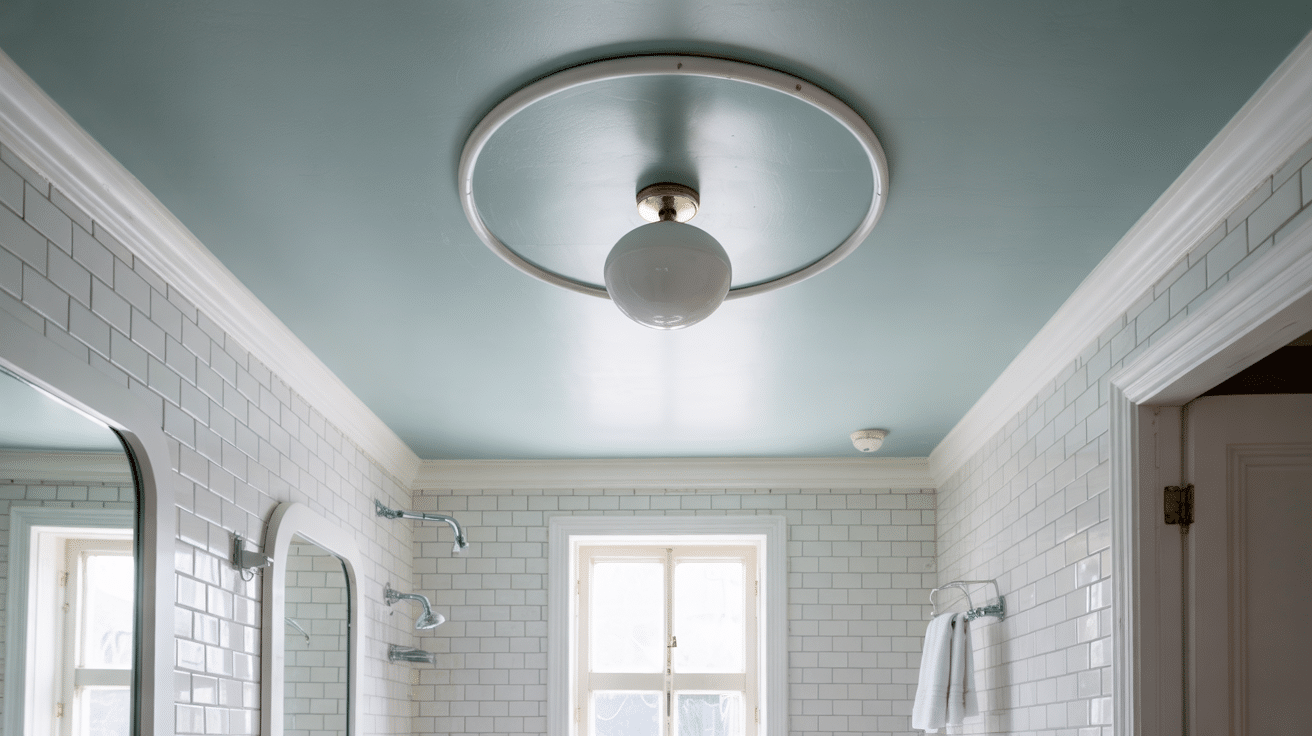
Flat paint creates a simple, non-reflective surface that hides small flaws in your ceiling. While not typically the first choice for bathrooms, newer flat paints with added mildew resistance can work in low-moisture bathrooms. The main drawback is that flat finishes can be harder to clean and may show water stains more readily.
- Hides ceiling imperfections and uneven textures
- Creates a soft, light-absorbing surface
- Offers a classic, clean look for bathrooms with good ventilation
Pro Tip: If using flat paint in a bathroom, choose a premium quality option with built-in moisture resistance and make sure your bathroom has a working exhaust fan.
2. Eggshell and Satin Paint
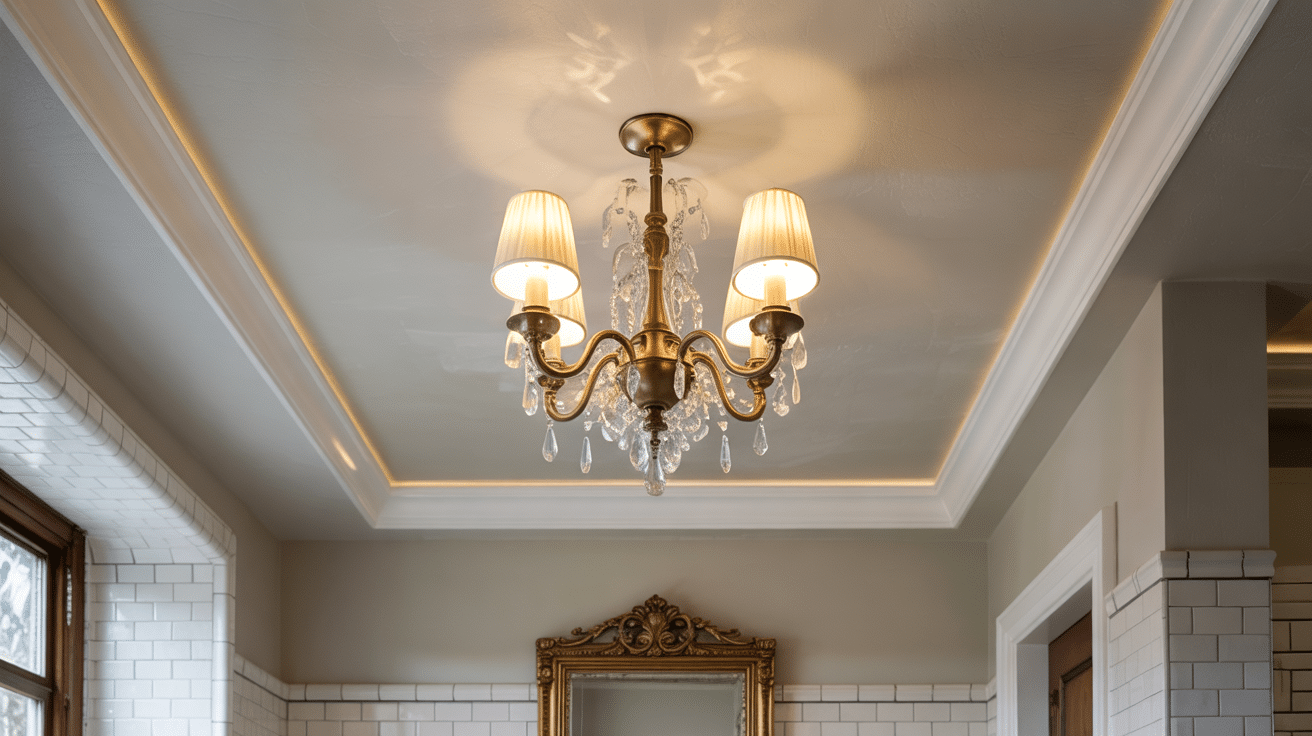
These mid-sheen finishes offer a good balance between flat and glossy options. Eggshell has a subtle glow while satin provides a bit more shine. Both resist moisture better than flat paint while still looking soft on ceilings. Their slight sheen helps ward off mildew while remaining modest enough to hide minor flaws.
- Better moisture resistance than flat paints
- Easier to clean than matte finishes
- Provides a gentle sheen that works well in most bathrooms
Pro Tip: Satin finish is often the sweet spot for bathroom ceilings—it has enough shine to shed moisture but won’t highlight every bump and crack in your ceiling.
3. Semi-Gloss and Gloss Paint
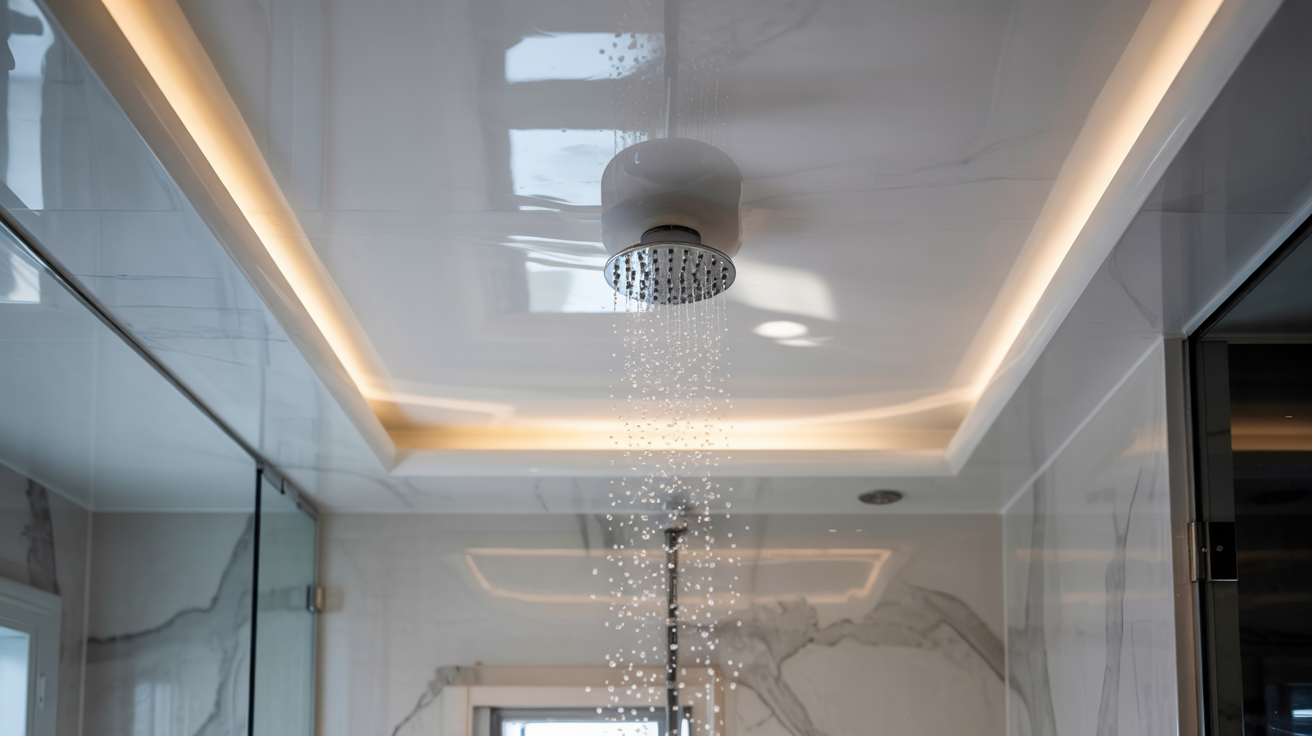
Higher-gloss paints form the most moisture-resistant surface available in standard paint options. Their hard, slick finish repels water and stands up to frequent cleaning. The notable shine also reflects light, which can make small bathrooms feel brighter and more open. These paints work especially well in very steamy bathrooms with poor ventilation.
- Highly resistant to moisture, mold, and mildew
- Easiest finish to clean and maintain
- Reflects light to make the bathroom brighter
Pro Tip: When applying glossy paints to ceilings, use smooth, even strokes in good lighting to avoid visible roller marks that show more on shiny surfaces.
4. Specialty Bathroom Paints
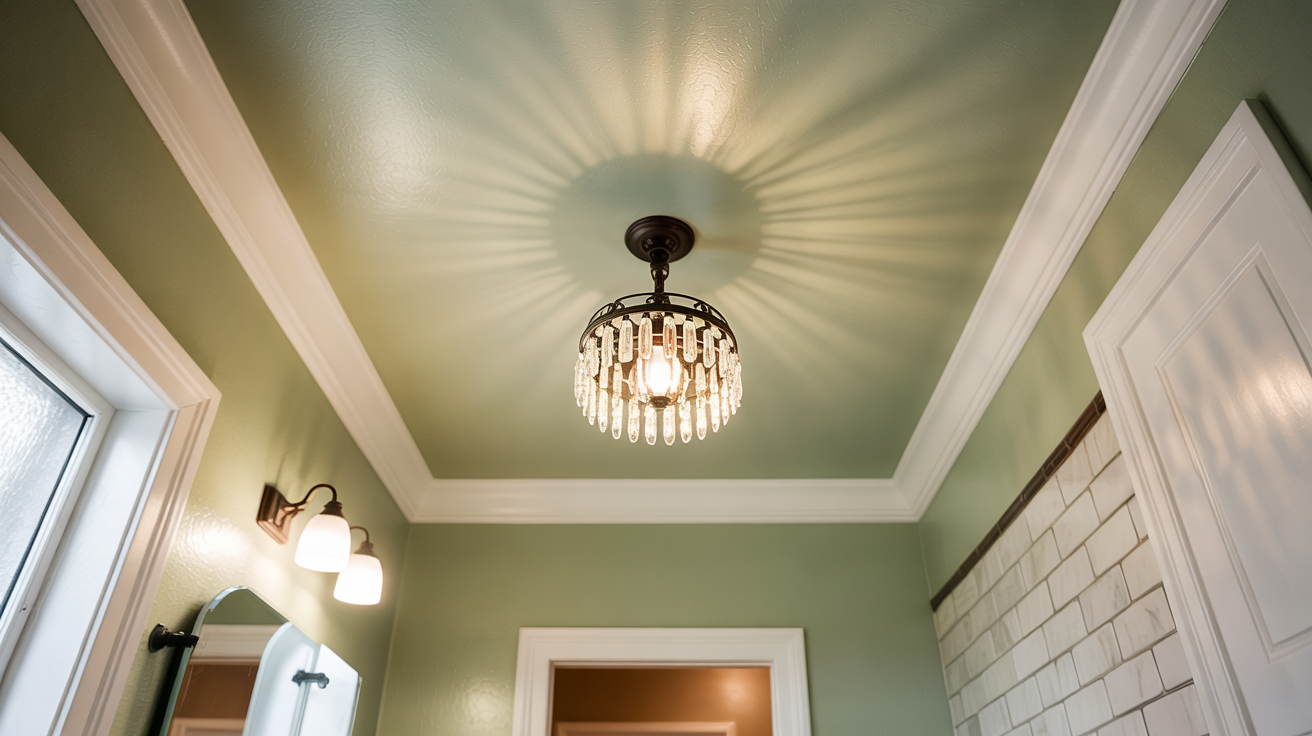
Paints made just for bathrooms contain extra additives to fight moisture problems. These specialty formulas often include mildewcides and moisture barriers that standard paints lack. While they cost more than regular paint, they can save money over time by reducing the need for repainting and repairs.
- Contains specific anti-microbial agents to prevent mold growth
- Forms an extra-strong moisture barrier
- Often requires fewer coats for good coverage
Pro Tip: Look for bathroom paints with EPA-approved mildewcides if your bathroom has ongoing moisture issues or previous mold problems.
How to Choose the Right Paint for Your Bathroom Ceiling
Finding the perfect paint for your bathroom ceiling depends on several key factors unique to your space.
Consider Your Bathroom Size and Ventilation
The size of your bathroom and its airflow directly affect which paint will work best.
- Small bathrooms with poor ventilation need higher-gloss paints
- Larger bathrooms with good exhaust fans can use lower-sheen options
- Daily shower usage matters—busy bathrooms need extra protection
Bathrooms without fans or windows need paint with the highest moisture resistance you can find.
Consider Existing Paint
The paint already on your ceiling affects your new paint job’s success.
- Test if current paint is oil-based or water-based
- Look for signs of problems like peeling or mold
- Glossy surfaces need sanding or priming first
Remove loose paint completely. For ceilings with previous mold, use a mold-killing primer first.
Color Considerations
Your color choice changes how the room feels and functions.
- Light colors make bathrooms feel bigger
- Soft blues create a calm feel and hide minor water stains
- Extending wall color onto the ceiling can make low ceilings look higher
Very light colors show water stains less than medium tones. Test colors under both natural and artificial bathroom lighting before deciding
7 Common Mistakes to Avoid When Painting a Bathroom Ceiling
1. Wrong Paint Selection: Using standard wall paint instead of moisture-resistant bathroom paint leads to premature peeling, mold growth, and frequent repainting.
2. Primer Neglect: Skipping primer on bathroom ceilings prevents proper paint adhesion, especially in humid conditions, causing bubbling and flaking within months.
3. Paint Overload: Applying too much paint on rollers creates drips, uneven texture, and longer drying times that invite moisture damage before the paint fully cures.
4. Poor Ventilation: Failing to open windows or run fans while painting slows drying time, traps paint fumes, and can result in an improperly cured finish that fails quickly.
5. Surface Preparation Shortcuts: Not cleaning the ceiling before painting traps dirt and mildew under new paint, preventing proper adhesion and causing visible imperfections.
6. Single Coat Application: Attempting to save time with just one coat results in thin coverage that won’t stand up to bathroom moisture and will require more frequent touch-ups.
7. Waiting Too Long: Delaying repainting after noticing signs of wear allows moisture to penetrate the ceiling, potentially causing structural damage that requires costly repairs.
Conclusion
Choosing the best paint for your bathroom ceiling makes a real difference in both looks and function. The right paint stops moisture problems before they start and keeps your bathroom looking fresh for years.
Remember to match your paint choice to your bathroom’s size, ventilation, and usage. For most bathrooms, a moisture-resistant paint with a satin or semi-gloss finish offers the best balance of durability and appearance.
Take time to prepare your ceiling properly, use quality primers, and apply two coats for lasting results. Avoid rushing the job or cutting corners with standard wall paints.
With the right paint and careful application, your bathroom ceiling will stay clean, bright, and problem-free. Your wallet will thank you too, as you’ll spend less time and money on repairs down the road.

